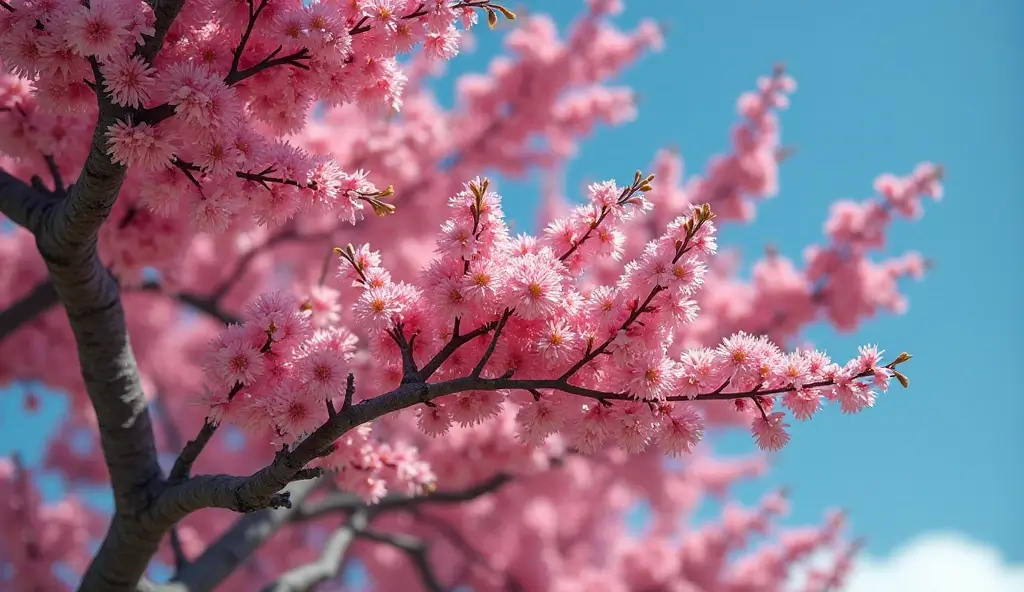Are you looking for a stunning native plant that delivers year-round interest while thriving in challenging conditions? The Mexican Buckeye (Ungnadia speciosa) might be exactly what your landscape needs. With its spectacular spring blooms, distinctive foliage, and remarkable drought tolerance, this Texas native deserves a prime spot in sustainable landscapes across the Southwest.
As a multi-season showstopper, Mexican Buckeye offers vibrant pink flowers in early spring, lush summer foliage, clear yellow fall color, and fascinating seedpods that persist into winter. Best of all, it accomplishes this with minimal water and care once established. Let’s explore everything you need to know about this remarkable native plant, from identification to planting and long-term care.
Table of Contents
What is a Mexican Buckeye? (Identification & Basics)
The Mexican Buckeye (Ungnadia speciosa) is a deciduous, multi-trunked shrub or small tree native to the southwestern United States and northern Mexico. Despite its common name, it’s important to note that Mexican Buckeye isn’t a true buckeye (genus Aesculus) at all. This distinction matters particularly when considering toxicity and growth habits.
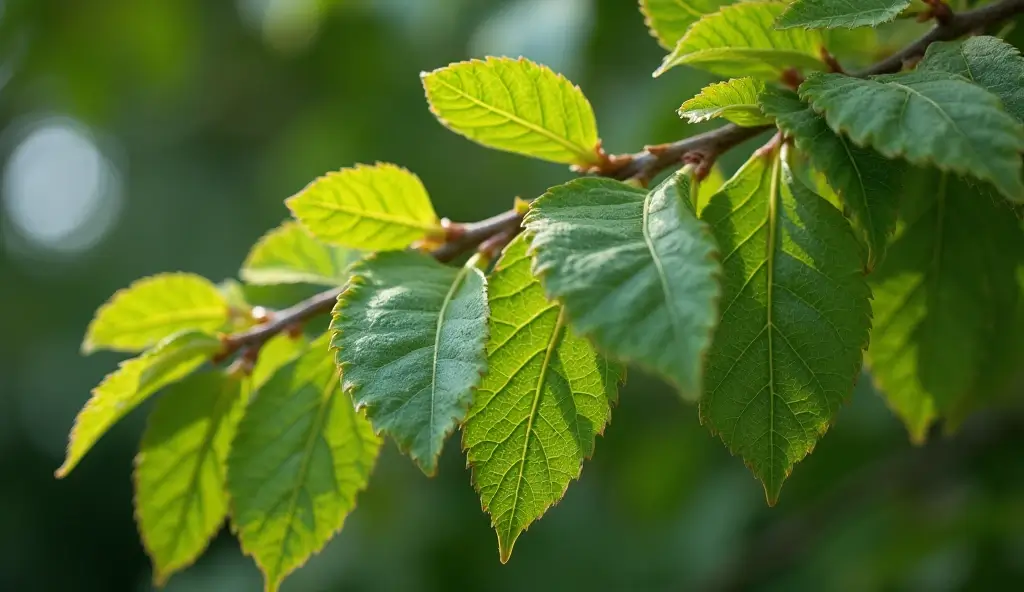
Detailed Description
Mexican Buckeye typically grows as a large shrub or small tree, reaching 8-12 feet tall and wide in most garden settings, though it can occasionally grow to 20 feet in ideal conditions. Its growth habit is naturally multi-stemmed, creating an attractive vase-shaped form with age.
The bark is grayish-brown, developing an intriguing texture with shallow furrows and thin scales as it matures. Young stems are smooth with a reddish-brown hue.
The leaves are perhaps one of its most distinctive features—pinnately compound with 5-9 leaflets arranged along a central stem. Each glossy green leaflet is 2-4 inches long with finely serrated edges. The foliage emerges with a bronze tint in spring before maturing to a deep green that provides excellent summer shade.
Visual Identification
When identifying Mexican Buckeye in the landscape, look for:
- A multi-trunked growth habit with a rounded to vase-shaped crown
- Compound leaves with 5-9 leaflets arranged along a central stem
- Early spring flowers in clusters of bright pink to magenta
- Distinctive three-lobed seed capsules containing dark, shiny seeds
Scientific Classification
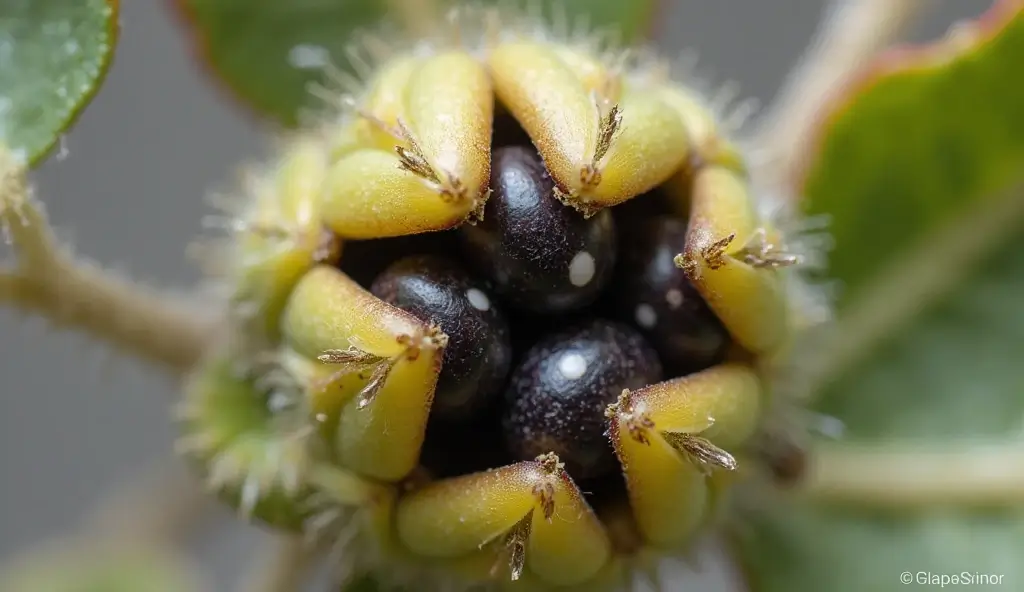
Mexican Buckeye belongs to the Sapindaceae family (Soapberry family), which includes other notable plants like maples and horse chestnuts. Its scientific classification is:
| Classification | Name |
|---|---|
| Kingdom | Plantae |
| Order | Sapindales |
| Family | Sapindaceae |
| Genus | Ungnadia |
| Species | U. speciosa |
This classification places it in a different family than true buckeyes (Aesculus), which belong to the Hippocastanaceae family.
“Buckeye” Name Origin
The common name “buckeye” comes from the distinctive appearance of its seeds, which bear a striking resemblance to deer eyes. Each glossy, dark brown to black seed has a lighter circular mark, creating the eye-like appearance. These seeds emerge from fascinating three-lobed capsules that split open when ripe, revealing their treasure inside.
Stunning Seasonal Interest (Why Grow It?)
Mexican Buckeye offers outstanding year-round interest that makes it valuable in landscaping across the Southwest. Let’s explore its seasonal highlights that make growing Mexican Buckeye so rewarding.
Spring Flowers
Perhaps the most spectacular feature of Mexican Buckeye is its stunning early spring flower display. Typically blooming in March to April before the leaves fully emerge, the plant becomes covered with clusters of bright pink to magenta, fragrant flowers. Each flower features five delicate petals and prominent stamens, creating a cloud of color that attracts early-season pollinators to the garden.
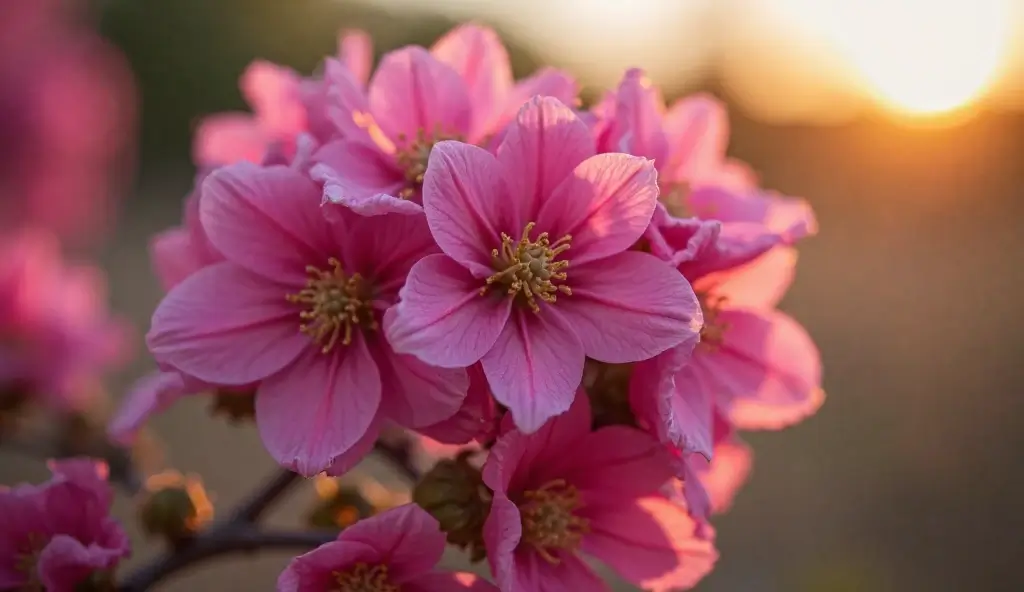
The timing of these blooms is particularly valuable in the landscape, as they appear when many other plants are just beginning to wake from winter dormancy, providing an early source of nectar for beneficial insects.
Summer Foliage
After flowering, Mexican Buckeye leafs out with attractive pinnately compound foliage that creates a lush, cooling canopy during hot summer months. The deep green leaves provide excellent texture in the landscape and remain attractive throughout the growing season, even during extended dry periods once the plant is established.
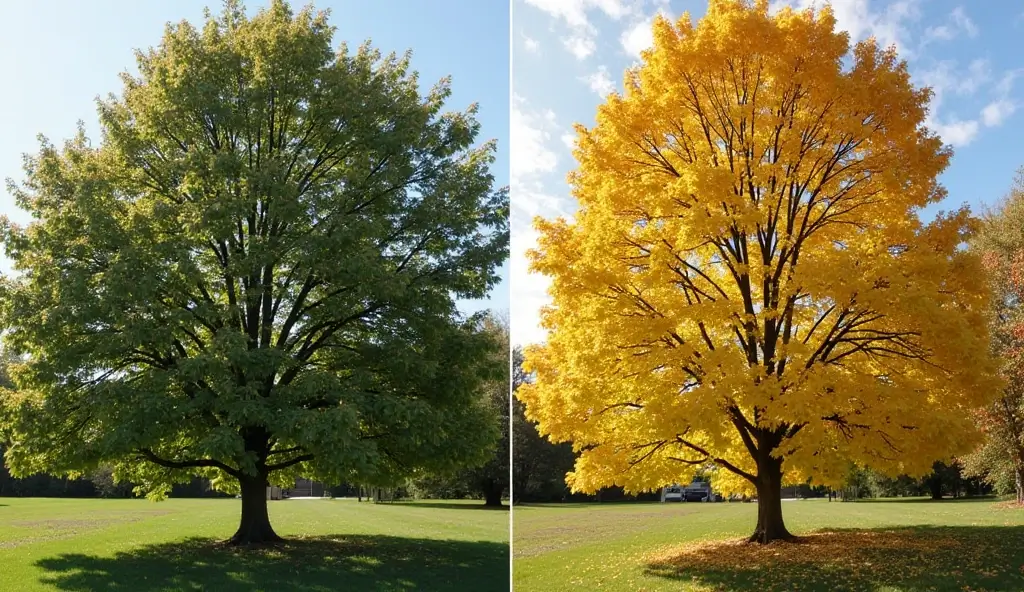
The summer form of Mexican Buckeye offers a soft, rounded silhouette that works beautifully as a backdrop for other flowering perennials or as a specimen plant in its own right.
Fall Color
As temperatures cool in autumn, Mexican Buckeye rewards gardeners with a final seasonal display as its compound leaves transform to clear yellow. While not as spectacularly vibrant as some fall-color champions, the soft golden hues provide a gentle transition in the autumn landscape, especially beautiful when backlit by late afternoon sun.
Interesting Seed Pods
Following the flowers, Mexican Buckeye develops distinctive seed pods that add unique visual interest. These three-lobed capsules start green, gradually hardening and turning brown as they mature. By late summer or early fall, they split open to reveal the glossy, dark seeds inside.
The seed pods persist on the plant well into fall and sometimes winter, providing extended seasonal interest and a conversation piece in the garden. Their architectural quality adds textural interest even after leaves have fallen.
Native Range & Growing Zones
Understanding where Mexican Buckeye naturally thrives helps gardeners determine if it’s suitable for their location and how to create optimal growing conditions.
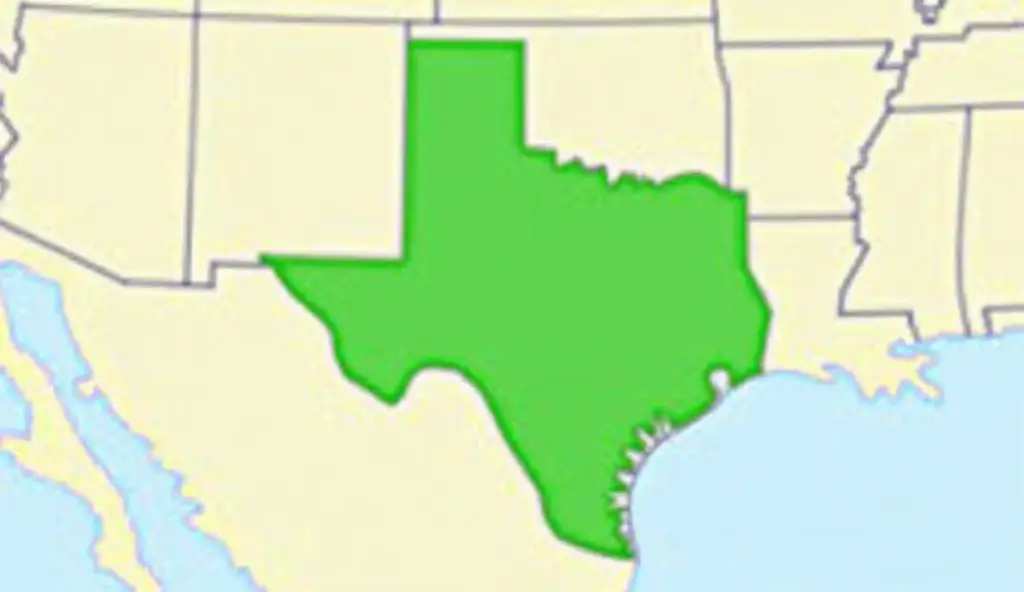
Where Does it Naturally Grow?
Mexican Buckeye is native to limestone slopes, canyons, and rocky areas across central and west Texas, extending into southern New Mexico and northern Mexico. It’s particularly common in the Texas Hill Country, Edwards Plateau, and along the Rio Grande.
The USDA PLANTS Database confirms its native range and documents its presence primarily in Texas and New Mexico.
In its native habitat, it’s often found growing in partial shade of larger trees or on north-facing slopes where it receives some protection from the intense afternoon sun of the Southwest. It naturally occurs in well-drained, often rocky or limestone-based soils.
USDA Hardiness Zones
Mexican Buckeye thrives in USDA Hardiness Zones 7-9, You can confirm its cold tolerance on the USDA’s Plant Hardiness Zone Map. where it can handle winter temperatures down to about 0°F (-18°C) once established. In colder regions at the edge of its hardiness range, planting in a protected location can help ensure success.
While the plant can handle brief dips below its rated hardiness, prolonged cold can damage or kill it, particularly when young. In marginal zones, consider planting in a sheltered microclimate near a south-facing wall where it will receive additional warmth.
Planting Mexican Buckeye
Successful establishment is key to enjoying the many benefits of Mexican Buckeye. Let’s explore the best practices for planting this native treasure.
When to Plant

The ideal times to plant Mexican Buckeye are:
- Fall (October-November): Preferred in most of its growing range, as this gives the plant time to establish roots before summer heat
- Early Spring (February-March): A good second option, but will require more attentive watering during the first summer
Avoid planting during the extreme heat of summer, which puts unnecessary stress on the establishing plant.
Choosing a Location
When selecting the perfect spot for your Mexican Buckeye, consider:
Sun Exposure: Mexican Buckeye performs best in full sun to partial shade. In the hottest parts of its range (zones 8-9), afternoon shade is beneficial, while in cooler areas (zone 7), fuller sun exposure will promote the best flowering.
Space Considerations: Allow at least 10-12 feet of space in all directions for the mature size of the plant. When planting near structures, position at least 6-8 feet away from foundations, walls, or paved areas to accommodate the root system.
Viewing Angle: Consider planting where the spectacular spring flowers can be appreciated from windows or outdoor seating areas.
Soil Requirements
Mexican Buckeye is remarkably adaptable to soil conditions but has some specific preferences:
- Drainage: Excellent drainage is absolutely critical. Mexican Buckeye will not tolerate wet feet or soggy soil conditions.
- pH: Naturally adapted to alkaline conditions (pH 7.0-8.2), but tolerates slightly acidic soils as well.
- Type: Thrives in rocky, limestone-based soils but adapts to loam, sandy loam, and even clay soils if drainage is adequate.
- Fertility: Adapts to lean soils and doesn’t require rich organic matter.
If your soil has poor drainage, consider planting on a slight mound or in a raised bed to ensure root health.
Step-by-Step Planting Guide
Follow these steps for successful Mexican Buckeye establishment:
- Dig the hole: Create a planting hole twice as wide as the root ball but only as deep as the container height. The wide hole encourages lateral root growth.
- Amend soil (if necessary): In heavy clay soils, incorporate some decomposed granite or coarse sand to improve drainage. In most cases, minimal amendment is needed.
- Position the plant: Place the Mexican Buckeye in the center of the hole with the top of the root ball level with or slightly above the surrounding soil surface. Never plant too deeply.
- Backfill: Carefully return the native soil to the hole, gently firming (not compacting) around the roots. Create a slight basin around the plant for initial watering.
- Water deeply: Saturate the planting area thoroughly, allowing water to settle the soil around the roots.
- Apply mulch: Spread 2-3 inches of mulch around the base of the plant, keeping it 2-3 inches away from the trunk. Use either organic mulch like shredded hardwood or inorganic mulch like decomposed granite.
Planting from Seed vs. Nursery Plant
Nursery Plants:
- Pros: Immediate visual impact, faster establishment, guaranteed success rate
- Cons: Higher cost, more limited availability, fewer genetic options
Seed Growing:
- Pros: Inexpensive, potential for larger quantities, genetic diversity
- Cons: Requires patience (2-3 years before significant size), specific germination requirements, lower success rate
If growing from seed, collect them when the capsules split open in fall. The seeds require scarification (nicking the hard seed coat) followed by cold stratification for 4-8 weeks to break dormancy and encourage germination.
Mexican Buckeye Care & Maintenance
Once established, Mexican Buckeye is remarkably low-maintenance, making it perfect for busy gardeners or those seeking sustainable landscape options.
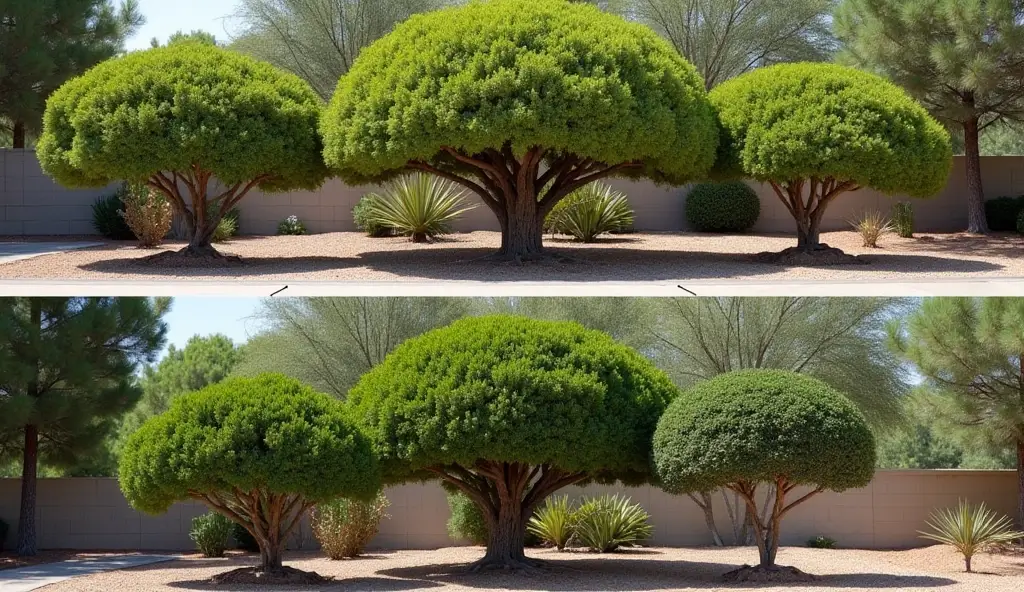
Watering
Mexican Buckeye showcases impressive drought tolerance once established, but proper watering during the establishment phase is critical:
First Year:
- Water deeply once weekly during growing season
- Increase to twice weekly during extreme heat periods
- Reduce to every 2-3 weeks during dormant season
Established Plants (2+ years):
- Water only during extended drought (3+ weeks without rain)
- Deep, infrequent watering is better than frequent shallow watering
- Watch for wilting or leaf curl as signs of drought stress
Overwatering Signs: Yellowing leaves, leaf drop, or soggy soil around the base Underwatering Signs: Wilting, crispy leaf edges, premature leaf drop in summer
Fertilizing
Mexican Buckeye has evolved to thrive in relatively lean soil conditions and generally requires minimal fertilization:
- Native Settings: No supplemental fertilizer needed
- Poor Soils: Apply a light application of slow-release, low-nitrogen fertilizer in early spring
- Container Plants: Apply half-strength balanced fertilizer once in spring
Avoid high-nitrogen fertilizers, which can promote excessive foliage at the expense of flowers and overall plant health.
Pruning
Proper pruning helps maintain the natural beauty of Mexican Buckeye while encouraging healthy growth:
- Timing: Late winter (January-February) before spring growth begins
- Light Pruning: Remove dead or damaged branches annually
- Structural Pruning: For tree form, gradually remove lower branches and select 1-3 main trunks
- Shrub Form: If preferred, allow multiple stems and simply shape as needed
Mexican Buckeye responds well to pruning but doesn’t require extensive maintenance to maintain its attractive form.
Pest & Disease Resistance
One of the many benefits of growing Mexican Buckeye is its general resistance to pests and diseases:
- Disease Resistance: Rarely troubled by fungal or bacterial issues
- Pest Resistance: Occasionally hosts native butterfly larvae (a benefit rather than problem)
- Primary Concern: Root rot in poorly drained locations
The most common problems arise from improper siting (too wet) rather than actual pest or disease susceptibility, emphasizing the importance of good drainage.
Propagation
For those interested in increasing their Mexican Buckeye collection or sharing with friends, these propagation methods prove most successful.
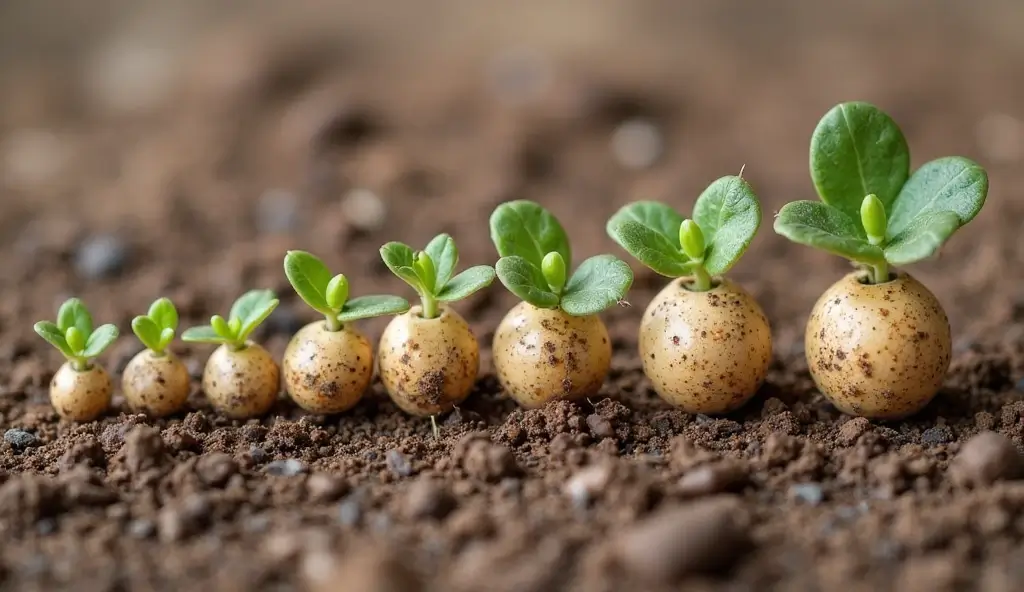
Seed Propagation
Collecting and growing Mexican Buckeye from seed is relatively straightforward but requires patience:
- Collection: Gather seeds in fall when capsules split open, revealing the shiny dark seeds
- Preparation: Scarify seeds by nicking the hard outer coat with a file or sandpaper
- Stratification: Place scarified seeds in moist sand or peat moss in a plastic bag in the refrigerator for 4-8 weeks
- Planting: Sow 1/2 inch deep in well-draining potting mix
- Germination: Expect germination in 2-4 weeks at temperatures around 70°F
- Growing On: Maintain seedlings in containers for the first year before transplanting to garden locations
Cuttings
Propagation by cuttings is challenging with Mexican Buckeye and has a lower success rate:
- Timing: Take semi-hardwood cuttings in early summer
- Treatment: Dip in rooting hormone (3000 ppm IBA)
- Medium: Plant in a very well-draining mix of perlite and vermiculite
- Conditions: Maintain high humidity with bottom heat around 75°F
- Success Rate: Expect only 30-40% rooting success
For most home gardeners, seed propagation remains the more reliable method if nursery plants aren’t available.
Toxicity: Clearing Up the Confusion
The toxicity of Mexican Buckeye is an important consideration, especially in gardens frequented by children and pets.
Address Directly
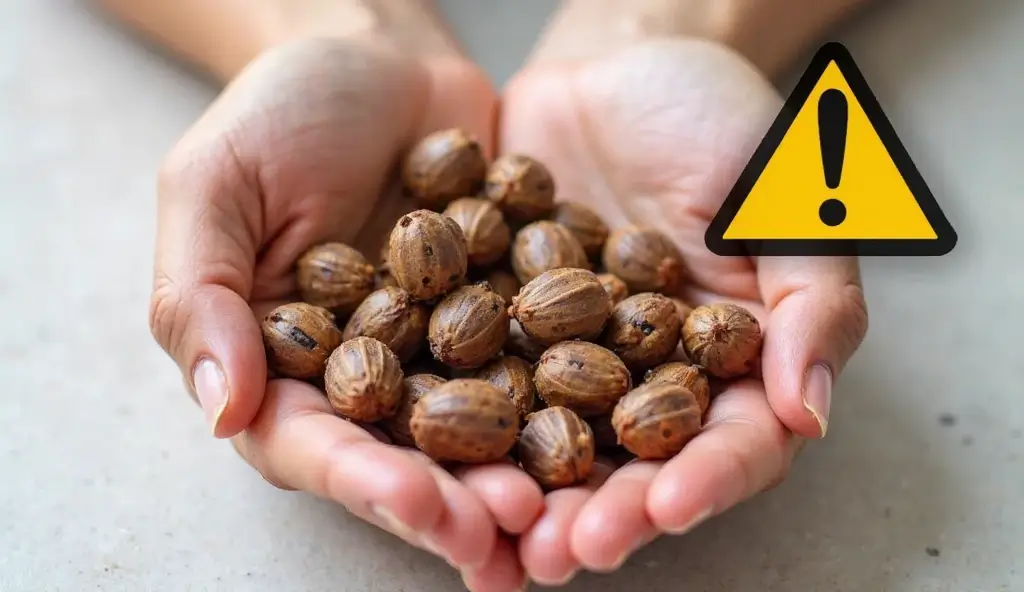
The seeds of Mexican Buckeye contain toxic compounds that can cause gastrointestinal distress if ingested. All parts of the plant contain some level of toxicity, but the seeds have the highest concentration of harmful compounds.
Symptoms of ingestion may include:
- Nausea and vomiting
- Abdominal pain
- Diarrhea
- In severe cases, more serious complications
Distinguish from True Buckeyes
It’s important to reiterate that despite its common name, Mexican Buckeye (Ungnadia speciosa) is not a true buckeye (Aesculus species). However, both contain similar toxic compounds in their seeds, so the same precautions apply.
The primary difference is that Mexican Buckeye belongs to the Sapindaceae family while true buckeyes belong to the Hippocastanaceae family.
Safety
Take these precautions when growing Mexican Buckeye:
- Educate children about not eating any part of the plant, especially the attractive seeds
- Keep pets from chewing on fallen seeds or plant parts
- Consider removal of seed pods in fall if this is a significant concern
- Remember that toxicity is primarily through ingestion, not casual contact
The toxicity concern should be balanced with the significant ecological and ornamental value of the plant. With proper awareness, Mexican Buckeye can be safely incorporated into most landscapes.
Landscaping Ideas & Companion Plants
Mexican Buckeye’s versatility makes it a valuable addition to various landscape styles, particularly those emphasizing sustainable and regionally appropriate plantings.
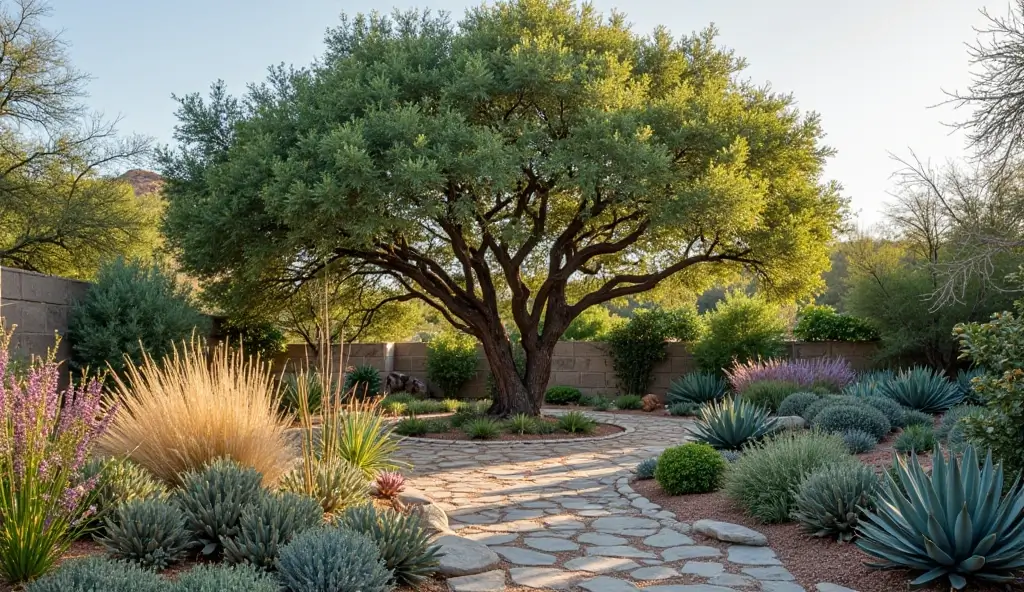
Uses
Consider these landscape applications for Mexican Buckeye:
- Specimen Plant: Showcase its multi-season interest as a focal point
- Background Structure: Use in mixed borders to provide height and structure
- Small Patio Tree: Train to single or multi-trunk tree form for shade in smaller spaces
- Native Garden Anchor: Incorporate as a foundation plant in wildlife gardens
- Xeriscape Component: Feature as a water-wise woody element in drought-tolerant designs
- Slope Stabilization: Utilize its root system to help prevent erosion on hillsides
Design Styles
Mexican Buckeye integrates beautifully into several design approaches:
- Naturalistic Gardens: Blends seamlessly with native plant communities
- Xeric Landscapes: Thrives in water-conserving garden designs
- Cottage Gardens: Provides structure and spring color in informal plantings
- Woodland Edges: Creates a transition between lawn areas and wilder spaces
- Southwest Contemporary: Offers organic forms that complement modern architecture
Companion Plants
These plants share similar growing requirements and complement Mexican Buckeye beautifully:
Shrubs & Small Trees:
- Texas Mountain Laurel (Sophora secundiflora)
- Desert Willow (Chilopsis linearis)
- Cenizo/Texas Sage (Leucophyllum frutescens)
Perennials:
- Blackfoot Daisy (Melampodium leucanthum)
- Gregg’s Mistflower (Conoclinium greggii)
- Autumn Sage (Salvia greggii)
- Mealy Blue Sage (Salvia farinacea)
Accent Plants:
- Yucca species (Y. rostrata, Y. pallida)
- Agave species (A. parryi, A. havardiana)
- Sotol (Dasylirion species)
Groundcovers:
- Woolly Stemodia (Stemodia lanata)
- Damianita (Chrysactinia mexicana)
- Snake Herb (Dyschoriste linearis)
When designing with Mexican Buckeye, consider positioning it where its spring flowers can be appreciated but where it also provides a backdrop for summer and fall bloomers, creating year-round interest.
Wildlife Value
Mexican Buckeye offers significant ecological benefits, supporting multiple wildlife species throughout the seasons.
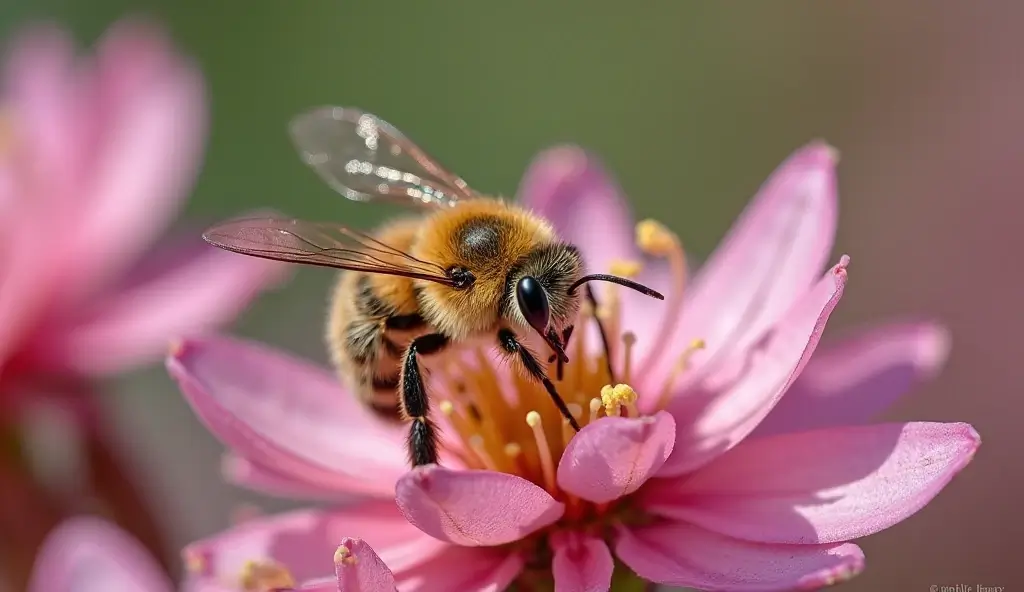
Pollinators
The early spring flowers of Mexican Buckeye provide crucial nectar sources when many other plants haven’t yet begun flowering:
- Bees: Attracts various native bee species at a critical time in their life cycle
- Butterflies: Supports early-emerging butterfly species
- Other Insects: Provides food for beneficial insects that help control garden pests
Butterfly Host Plant
Mexican Buckeye serves as a larval host plant for:
The North American Butterfly Association identifies Mexican Buckeye as a host plant for early-season butterfly species such as Henry’s Elfin and Echo Azure, supporting pollinator diversity in native landscapes.
- Henry’s Elfin butterfly (Callophrys henrici)
- Echo Azure butterfly (Celastrina echo)
The presence of these caterpillars should be seen as a sign of a healthy ecosystem rather than a pest problem. Any minimal foliage damage is quickly replaced by new growth.
Birds
While birds don’t consume the toxic seeds, Mexican Buckeye still provides significant bird habitat:
- Nesting Sites: The multi-branched structure offers protected nesting locations
- Cover: Dense summer foliage provides shelter from predators and elements
- Perching: Branch architecture creates excellent lookout and resting spots
By incorporating Mexican Buckeye into your landscape, you’re creating a mini wildlife sanctuary that supports local biodiversity.
Regional Focus
Growing Mexican Buckeye successfully means understanding how to adapt care to regional conditions.
Tips for Texas Gardeners
In its native Texas range, Mexican Buckeye thrives with these special considerations:
- Hill Country: Plant on north-facing slopes or where afternoon shade is available
- Central Texas: No additional limestone needed in naturally alkaline soils
- East Texas: Ensure excellent drainage in heavier clay soils; consider slight mounds
- South Texas: Provide reliable moisture during establishment phase in extreme heat
- Companion Plants: Pair with Lindheimer Muhly grass, Heartleaf Skullcap, and Plateau Goldeneye for authentic Texas Hill Country look
Tips for Arizona/New Mexico Gardeners
Outside its native range, adapt care for western conditions:
- Arizona: Provide afternoon shade in low desert regions; performs better at higher elevations
- New Mexico: Excellent choice for Santa Fe/Albuquerque areas; protect from harsh winter winds
- Supplemental Water: May need slightly more irrigation in extremely arid regions
- Mulch: Use inorganic mulch like decorative rock to suppress weeds while allowing soil to dry between waterings
- Companion Plants: Pair with Desert Spoon, Apache Plume, and Penstemon species
Frequently Asked Questions (FAQ)
Is Mexican Buckeye poisonous?
Yes, the seeds of Mexican Buckeye contain toxic compounds that can cause gastrointestinal distress if ingested. While casual contact is not harmful, ingestion should be avoided, especially by children and pets.
According to the University of Texas at Austin’s Plant Database, all parts of the Mexican Buckeye contain saponins, which can be toxic to humans and animals if ingested.
How fast does Mexican Buckeye grow?
Mexican Buckeye grows at a moderate rate, typically adding 1-2 feet of height per year under optimal conditions. Plants generally reach 8-12 feet tall within 5-7 years of planting.
How big does a Mexican Buckeye get?
In garden settings, Mexican Buckeye typically reaches 8-12 feet tall and wide at maturity. In ideal natural conditions, it can occasionally grow to 20 feet tall, though this is uncommon in cultivated landscapes.
Is Mexican Buckeye deer resistant?
Yes, Mexican Buckeye is generally deer resistant. The foliage contains compounds that make it unpalatable to deer, though in extreme conditions or with very high deer pressure, young plants may occasionally experience browsing.
When does Mexican Buckeye bloom?
Mexican Buckeye typically blooms in early spring, usually March to April, depending on regional temperatures. The pink flowers often appear before the leaves fully emerge, creating a spectacular display against the bare branches.
Does Mexican Buckeye need full sun?
Mexican Buckeye performs well in full sun to partial shade. In the hotter parts of its range (Central Texas, Arizona), afternoon shade is beneficial, while in cooler areas, fuller sun exposure will promote the best flowering.
Conclusion
The Mexican Buckeye (Ungnadia speciosa) offers a remarkable combination of beauty, resilience, and ecological value that few other plants can match. From its stunning spring flower display to its attractive summer foliage, clear fall color, and interesting seed pods, this native treasure provides year-round interest with minimal care.
For gardeners in the Southwest seeking sustainable landscaping solutions that don’t sacrifice beauty, Mexican Buckeye deserves a prime spot in the landscape. Its drought tolerance, pest and disease resistance, and support for local wildlife make it an exemplary choice for environmentally conscious gardening.
Whether you’re creating a native habitat, designing a water-wise landscape, or simply looking for a beautiful small tree with multiple seasons of interest, Mexican Buckeye rises to the challenge. By incorporating this regional gem into your garden, you’re not only creating a more beautiful space but also supporting the unique ecology of the American Southwest.

